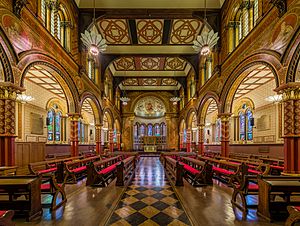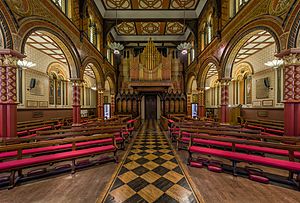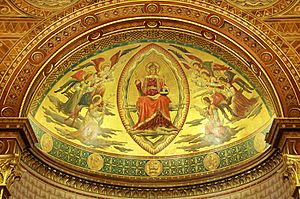Chapel of King's College London facts for kids
Quick facts for kids The Chapel of King's College London |
|
|---|---|

The chapel is a Grade I listed building. It was redesigned in 1864 by the famous architect Sir George Gilbert Scott.
|
|
| Status | Active |
| Location | |
| Location | King's College London, Strand, London |
| Architecture | |
| Architectural type | Chapel |
| Completed | 1831 - Sir Robert Smirke 1864 - Sir George Gilbert Scott |
The Chapel of King's College London is a historic 19th-century chapel at King's College London in England. It is a special building, listed as Grade I, which means it is protected for its historical importance.
The chapel was first designed by Sir Robert Smirke in 1831. However, it was completely redesigned in 1864 by Sir George Gilbert Scott, a famous architect from the Victorian period known for his amazing Gothic style.
Contents
History of the Chapel
The chapel has always been an important part of King's College. It was built right in the center of the main King's Building, one floor above the Great Hall. A large, grand staircase leads up to it.
The First Chapel
The original chapel, finished in 1831, was designed by Sir Robert Smirke. It was described as a low, wide room built in the popular style of the time.
By the 1850s, however, people's tastes had changed. The college chaplain, E. H. Plumptre, thought the chapel looked too plain and "unworthy" of the college. In 1859, the college council agreed and decided it was time for a major update.
A Grand Redesign
The college hired Sir George Gilbert Scott, one of the most famous architects of the time, to create a new design. Scott suggested building the new chapel in the style of an ancient basilica. A basilica was a type of large public building in ancient Rome that was later used as a model for churches.
His idea was approved, and the new chapel was finished in 1864. The project cost over £7,000, which was a very large amount of money back then.
Changes Over the Years
Because the chapel sits above the Great Hall, Scott had to use clever, lightweight building methods for the walls and arches.
The chapel has seen many changes since it was built.
- The original roof had a pattern of large stars, but this was replaced in the 1930s.
- During World War II, the beautiful stained glass windows were damaged.
- After the war, in 1948, architect Stephen Dykes Bower was hired to repair the damage. He replaced the broken windows with tinted glass, which is still there today.
In 2001, the chapel was restored and updated to make it a welcoming space that respects its history while being useful for today's students.
The Beautiful Apse
The apse is the curved, dome-like area at the front of the chapel. Its ceiling features a stunning mosaic copy of a work by the artist Salviati. It shows Christ in Majesty with angels all around him.
On the walls, you can see panels with the college's motto, Sancte et Sapienter, which is Latin for "With Holiness and Wisdom." There are also paintings of important figures from the history of the Christian church.
Leadership at the Chapel
Deans
The Dean is the head of the religious community at King's College.
Organists
Music is a big part of life at the chapel. Many talented organists have played here over the years.
- William Henry Monk (1854–1889) was the organist for 35 years.
- David Trendell (1992–2014) was a more recent organist.
- Joseph Fort has been the organist since 2015.
Chaplains
Chaplains are priests or ministers who provide support and guidance to students and staff at the college.



